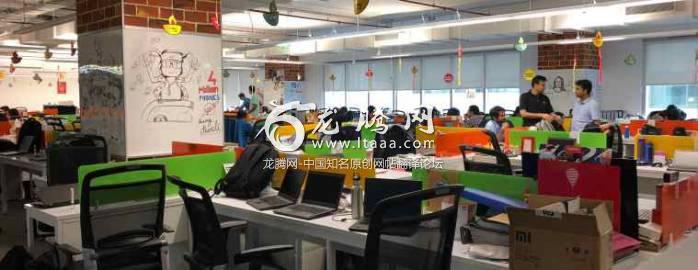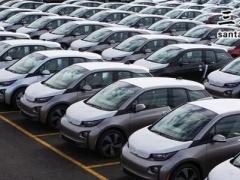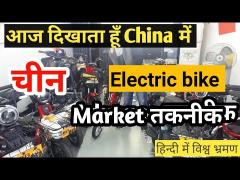【印度快报】小米创始人雷军专访:“印度制造富有远见,我们鼓励供应商在印度设厂” [印度媒体]
在印度,很多人都不知道雷军的名字。但提到他的公司小米,每个人都知道这个智能手机品牌,小米现在的市场份额和长期的市场领导者三星一样。不过,雷军的小米是一家初创公司,在你比较它在全球范围内所面临的挑战时,会发现它的规模仍然很小。Nandagopal Rajan在与企业家雷军交谈时,小米在印度成为了第一名,在印度市场上发展,在印度制造,在智能手机领域创新。
The name Lei Jun might not be recognised by many in India. But mention his company Xiaomi and everyone knows the smartphone brand which now has the same market share as long-time market leader Samsung. But then Lei Jun’s Xiaomi is a startup that is still small when you compare the scale of the companies it is challenging across the world. Nandagopal Rajan speaks to serial entrepreneur Lei Jun on Xiaomi becoming No 1 in India, improvising for the local market, Make in India and innovation in the smartphone segment.
在印度,很多人都不知道雷军的名字。但提到他的公司小米,每个人都知道这个智能手机品牌,小米现在的市场份额和长期的市场领导者三星一样。不过,雷军的小米是一家初创公司,在你比较它在全球范围内所面临的挑战时,会发现它的规模仍然很小。Nandagopal Rajan在与企业家雷军交谈时,小米在印度成为了第一名,在印度市场上发展,在印度制造,在智能手机领域创新。
How does it feel becoming the largest smartphone manufacturer in India? Has it happened faster than you expected?
成为印度最大的智能手机制造商感觉如何?事情进展的比你预期的要快吗?
In 2015 April, I had expected us to take three to five years to become No 1. Actually, it took us just two years and one quarter. It is something very exciting. It really means the Indian consumers could resonate with the Xiaomi brand, the Xiaomi products and our values.
在2015年4月,我曾预计我们将需要3到5年的时间才能成为第一。实际上,我们只花了两年零四分之一的时间。这是非常令人兴奋的事情。这意味着,印度消费者与小米品牌、小米产品和我们的价值观产生共鸣。
What do you think is the primary reason for this success?
你认为成功的主要原因是什么?
There are three elements to this success. One, high-quality products; two, our honest and affordable pricing; and three, our very strong local team lead by Manu Jain participating in the Made in India programme. All these elements are recognised by the Indian customers. Even though we are a global company, we are also a very localised Indian company. Since the day we entered the market, my instruction has been that we have to become a local Indian company.
这个成功有三个要素。1、高质量的产品;第二,诚实和可承受的定价;第三,我们有强大的由Manu Jain领导的印度本土团队。所有这些元素都得到了印度客户的认可。尽管我们是一家全球性的公司,但我们也是一家非常本地化的印度公司。自从我们进入市场以来,我指的是,我们必须成为一家当地的印度公司。
Xiaomi has had this very unique marketing strategy. Did you have to improvise that for the Indian market?
小米的营销策略非常独特。你会即时使用在印度市场吗?
First of all, we are an e-commerce company. So why do we make an e-commerce platform? Because of its high efficiency. It takes a lot of costs to make a great quality product. If you want to sell it affordably, you need to use the technology of the Internet and e-commerce. Since the beginning of this year, we started entering offline in a big way, but we are very different from the other traditional smartphone companies as we are doing new retail. This is the concept that global juggernauts like Amazon and Alibaba have been talking about, the new retail.
首先,我们是一家电子商务公司。那么,我们为什么要打造一个电子商务平台呢?因为它的效率很高。制作高质量的产品需要花费很多的成本。如果你想以实惠的价格销售,你需要使用互联网和电子商务的技术。从今年年初开始,我们就开始大举进入线下,但我们与其他传统的智能手机公司截然不同,因为我们正在进行新的零售业务。这是亚马逊和阿里巴巴等全球巨头一直在谈论的一个概念,即新的零售业务。
Using e-commerce technology and methodology to do retail. We can actually make these products very affordable offline as well. That is why we would never go to a traditional retail model. So how do we do new retail well? The first example is Mi Home. In India, we now have ten of them with huge footfalls and each store selling a huge number of phones. The first store in India sold 20,000 phones a month, it is a big miracle in the retail industry.
使用电子商务技术和方法进行零售。实际上,我们可以让这些产品在线下也能负担得起。这就是为什么我们永远不会去传统的零售模式。那么我们如何做新的零售呢?第一个例子是米家。在印度,我们现在有10个这样的商店,每个商店都有大量的手机,每个商店都售出大量的手机。印度第一家商店每月售出2万部手机,这在零售业是一个巨大的奇迹。
What are your big learnings from the India market? Are you taking these learnings to other parts of the world?
你从印度市场学到什么?你是把这些经验带到世界的其他地方吗?
We have some great innovations in this market. For instance, the Mi Preferred Partner Programme is something the local team came up with and is now being implemented in our other markets. A lot of our global leads have come to India to learn these concepts.
我们在这个市场上有一些大的创新。例如,小米首选的合作伙伴项目是本地团队提出的,目前正在我们的其他市场实施。我们的许多国际主管都来到印度学习这些概念。
Are you hoping to take the online virality offline through your fan network? Does it work better in a country like India because of the strong family and community connections?
你希望通过你的粉丝网络从线上扩散到线下吗?在印度这样家庭和社区关系的密切关系的国家,它能更好地发挥作用吗?
Yes. We believe that treating our users as friends is a concept that will work well everywhere in the world. Along with the success in India and China, we also rank in top five in 12 other countries now. This philosophy will apply globally.
是。我们相信,把用户当作朋友对待是个在世界各地都能很好地发挥作用的概念。除了在印度和中国的成功,我们还在其他12个国家中排名前五。这种经营观念将在全球范围内应用。
How do you achieve your price? That has been your USP.
这样的(低)价格是怎么做到的?这已经成为了你独特的销售主张。(USP:独特销售主张,即USP理论 是R雷斯基于年代市场处于竞争初期的背景提出的营销理论)
For every product that we design, we will find the best talents across the world. And we will try our best to build the highest quality product that can be achieved. Then we hope to price it at cost; pretty much zero-per cent profit. That way over six to seven years, consumers tend to trust you more.
我们设计的每一个产品,我们都会找到世界上最优秀的人才。我们将尽最大努力,打造最优质的产品。然后我们希望以成本价来定价;几乎是零利润。如此6、7年后,消费者更倾向于信任你。
We are able to achieve up to half the cost of some of the products when compared to our competitors. We have very little advertising or promoters and hence we are returning the cost back to consumers. That is why we are reasonably priced. Even then our quality is still world class.
与我们的竞争对手相比,我们能够实现部分产品的仅其一半成本。我们很少有广告或推销商,我们将成本返还给消费者。这就是我们拥有合理定价的原因。即便如此,我们的产品质量仍然是世界级的。
Over the years Xiaomi has created a network of companies that create interesting products. Are you looking for such companies in India too?
多年来,小米已经建立了一个创造有趣产品公司网络,你也在印度寻找这样的公司吗?
Yes. We will try and build an incubator in India and work with more Indian startups to help them succeed. Of course, they will also help us. Xiaomi India can really accelerate India’s creativity and innovation. We have invested in six Indian startups so far.
是。我们将尝试在印度建立一个孵化器,并与更多的印度创业公司合作,帮助他们取得成功。当然,他们也会帮助我们。小米印度确实可以加速印度的创造力和创新。到目前为止,我们已经投资了6家印度创业公司。
What do you think about the culture of technology and innovation in India?
你对印度的技术和创新文化有什么看法?
India’s education system is actually very good. I am a big admirer of IIT, especially since Manu is from IIT… also because I don’t know which other universities are there in the country (chuckles). I have met Satya Nadella and Sundar Pichai. I think Indians are really smart and have met many of them. They are super strong on the technology front and this is why we have to be highly localised as a company.
印度的教育体系实际上非常好。我是IIT(印度理工学院)的仰慕者,尤其是知道Manu是IIT的。当然也因为我不知道在这个国家里还有哪些大学(笑声)。我见过Satya Nadella和Sundar Pichai。我认为印度人确实很聪明,并见过很多这样的人。他们在技术前沿非常强大,这也是为什么我们必须成为一家高度本地化公司的原因。
Is it becoming more and more difficult to innovate in the smartphone space?
在智能手机领域,创新越来越难了吗?
The top six players globally in the smartphone industry are super competitive. Because of this competitiveness, innovation is still happening. For instance, our Mi Mix phone was the first full-screen display bezel-less phone in the world. We started working on this four years ago and now it has become the norm. We have many patents in this area. We are the only company capable of creating this kind of material (jade-like finish with ceramic). At least in the short-term I don’t think we will hit a ceiling in terms of innovation in the smartphone industry.
在智能手机行业,全球排名前六的公司都非常有竞争力,正由于这种竞争,创新仍在继续 例如,我们的小米MIX手机是世界上第一个全面屏无边框的手机 我们四年前就开始研究这个问题了,现在它已经成为常态 我们在这个领域有很多专利 我们是唯一一家能制造这种材料的公司(陶瓷工艺) 至少在短期内,我不认为我们会在智能手机行业的创新方面达到一个上限。
Do you think a big disruptor will come and change the smartphone industry again?
你认为会有一个大的颠覆者将会再次改变智能手机行业吗?
There is a possibility. For example, the full-screen display (of the Mi Mix) is very different from that of the iPhone when it comes to industrial design. Why does everyone follow us? Because it is so innovative. The whole front is a screen and there is nothing else there. When you compare it to other phones, everything else is a different generation and outdated. This is why a phone like the iPhone 8 cannot sell in China now. There will be a lot of such innovation coming up in the future.
有这种可能性。例如,涉及到工业设计层面,全屏幕显示(小米Mix)与iPhone非常不同。为什么大家跟随我们?因为它是如此的创新。整个正面是一个屏幕,没有别的东西。当你把它和其他手机进行比较时,其他的手机都不是同一代,过时了。这就是为什么像iPhone 8这样的手机在中国卖不动。未来将会有很多这样的创新。
How do you look at the Indian environment when it comes to the ability to do business here and the lack of a component ecosystem here?
当谈到在这里商业氛围和组织生态缺乏时,你如何看待印度的环境?
India also needs to take a step-by-step approach to develop the manufacturing industry. Two decades ago China also followed the same step-by-step approach – start with assembly and slowly go to localisation of components. We have been trying to encourage our suppliers to start their factories in India. We already have a few of our factories set up in India and a few more that are being set up as our capacity has been reached. I think some component suppliers also will set up factories in India. But this takes time.
印度还需要采取循序渐进的方式来发展制造业。20年前,中国也遵循同样的循序渐进的方法——从装配开始,慢慢地走向组件本地化。我们一直在努力鼓励我们的供应商在印度开办他们的工厂。我们已经在印度建立了一些工厂,还有一些在我们的产能已经达到的情况下建立起来。我认为一些零部件供应商也会在印度设立工厂。但这需要时间。
PM Narendra Modi’s Made in India campaign is a visionary project that will improve India’s industrial capabilities, solve employment issue and develop the economy.
印度总理纳伦德拉莫迪的“印度制造”计划(译者注:是Made in India 其意是“在印度制造”不是Made by India“由印度制造” )是一个有远见的项目,将改善印度的工业能力、解决就业问题和发展经济。
That is also one of the key reasons why China has undergone a transformation in the past few years. Technological innovation is always step-by-step and you should not set up a too ambitious goal in the very beginning.
这也是中国在过去几年经历转型的关键原因之一。技术创新总是循序渐进的,你不应该在一开始就设定一个过于宏大的目标。
Where do you see Xiaomi… as a smartphone brand or a larger tech entity spread over other segments too?
你认为小米的定位在哪里?一个智能手机品牌还是一个更大型的广泛衍生到其它领域的科技实体?
Xiaomi is a very innovative model. We are in the smartphone business, the TV business and also in the laptop business. But we are also an Internet company and an e-commerce company. So we are a new species. We will probably position ourselves as a leading digital lifestyle brand.
小米是一个非常创新的模式。我们有智能手机业务,电视业务,以及笔记本电脑业务。但我们也是一家互联网公司和一家电子商务公司。所以我们是一个新物种。我们可能会把自己定位为一个领先的数字生活方式品牌。
How do you see Xiaomi five years down the line?
你如何看待小米未来5年的发展?
Every global citizen be able to enjoy the benefits and fun of technology thanks to Xiaomi. Today, thanks to Xiaomi and Redmi phones, a lot of Indians are able to enjoy the benefits of mobile internet. If they want to buy phones from other brands, the cost will be two times; or they could afford only cheaper low-quality phones.
每一个全球公民都将受益于小米,都能享受到技术带来的好处和乐趣。如今,得益于小米和红米手机,许多印度人都能享受到移动互联网带来的好处。如果他们想从其他品牌购买手机,成本将是两倍;或者他们只能买得起更便宜的低质量的手机。
What is the timeline you have set for becoming a truly global brand?
你为成为一个真正的全球品牌所设定的时间表是怎样的?
Now, we are in over 60 countries and are entering some of the more developed countries in Europe like Russia and Spain. Maybe by end of next year, we will consider North America. Even though we are already at a certain scale and very likely to enter Fortune 500 by next year, we are just seven years old. Actually, we are still a very innovative startup with just 16,000 employees.
现在,我们已经进入了60多个国家,正在进入一些更发达的欧洲国家,如俄罗斯和西班牙。也许到明年年底,我们将会考虑北美。尽管我们已经达到了一定的规模,并且很有可能在明年进入财富500强,我们成立仅7年。实际上,我们仍然是一家非常具有创新精神的初创公司,只有1.6万名员工。
We are talking about such scale with so few people — (in India Xiaomi has just 300 employees). Some of our competition in India has 100,000 people on their rolls.
如此规模,却只有很少有人——(小米印度仅有300名员工)。而一些我们的竞争对手在印度有10万员工。
How important is the Indian market for you?
印度市场对你来说有多重要?
It is a proven business model. In China we are number 1, in India we will become number 1 and people will now believe that we can become number 1 in many more markets now. The executive team has spent a lot of time thinking about the India market. Internally, in HQ we have prioritised India as our number 1 market.
这是一种经过验证的商业模式。在中国,我们是第一,在印度,我们将成为第一,相信我们可以在更多的市场中成为第一。高管团队花了很多时间思考印度市场。在国内,总部我们已经把印度作为我们的第一市场。
For example, from an R&D perspective, we have to fully consider the needs of the Indian users. For instance, India is a hotter climate, so when we design phones we have to consider how to control the temperature of the phone. We do so many different things to localise the products. From supply and production also, India has been a priority for the company. Even on this trip I have brought over 20 top executives from different departments to help the India team to continue to grow in the next few quarters.
例如,从研发的角度来说,我们必须充分考虑印度用户的需求。再比如,印度是一个更炎热的气候,所以当我们设计手机时,我们必须考虑如何控制手机的温度。我们做了许多不同的事情来将产品本地化。从供应和生产方面来说,印度一直是公司的首要任务。即使在这次旅程中,我也从不同的部门请来了20多名高管,帮助印度团队在未来几个季度继续增长。
Will we see all Xiaomi’s products come to India?
我们会看到小米的所有产品都来到印度吗?
We will curate the products that we believe Indian consumers will need. We might even consider setting up a Bangalore R&D centre to design products only for India.
我们将生产印度消费者需要的产品。我们甚至会考虑在班加罗尔设立一个研发中心,只为印度设计产品。
You have Ratan Tata as an investor. What have been your learning from him?
你有Ratan Tata做投资者。你从他那里学到了什么?
We respect Mr Tata for his success. Before I entered the Indian market, my only impression of India was Mr Tata. His is a very respectable enterprise. There are a few things that struck a chord with me, including the charity projects that they do. Xiaomi is a startup, but we also try our best by participating in charity projects. This is what we have learnt from Mr Tata.
我们尊重塔塔先生的成功。在我进入印度市场之前,我对印度的唯一印象就是塔塔先生。他是一个非常受人尊敬的企业家。有几件事引起了我的共鸣,包括他们所做的慈善项目。小米是一家创业公司,但我们也通过参与慈善项目来尽我们的一份力量。这就是我们从塔塔先生身上学到的。
Over the past few quarters, Indian smartphone manufacturers have struggled against the Chinese entrants. Do you have any advice for these companies?
过去几个季度,印度智能手机制造商一直在与中国企业的竞争 你对这些公司有什么建议吗?
The Chinese company learn a lot from great global companies. Perhaps a good advice for Indian companies might be to communicate and learn from Chinese companies and other global companies. Because the smartphone market is huge. If we all work on great products, the consumers will be super happy.
中国公司从全球大公司中学习了很多东西。或许对印度公司来说,一个好的建议可能是与中国公司和其他跨国公司交流和学习。因为智能手机市场是巨大的。如果我们都致力于伟大的产品,消费者将会非常高兴。
版权声明
我们致力于传递世界各地老百姓最真实、最直接、最详尽的对中国的看法
【版权与免责声明】如发现内容存在版权问题,烦请提供相关信息发邮件,
我们将及时沟通与处理。本站内容除非来源注明五毛网,否则均为网友转载,涉及言论、版权与本站无关。
本文仅代表作者观点,不代表本站立场。
本文来自网络,如有侵权及时联系本网站。
图文文章RECOMMEND
热门文章HOT NEWS
-
1
चाइना में रेडी और ठेले Local shops in china || L...
- 2
- 3
- 4
- 5
- 6
- 7
- 8
- 9
- 10
推荐文章HOT NEWS
-
1
चाइना में रेडी और ठेले Local shops in china || L...
- 2
- 3
- 4
- 5
- 6
- 7
- 8
- 9
- 10














